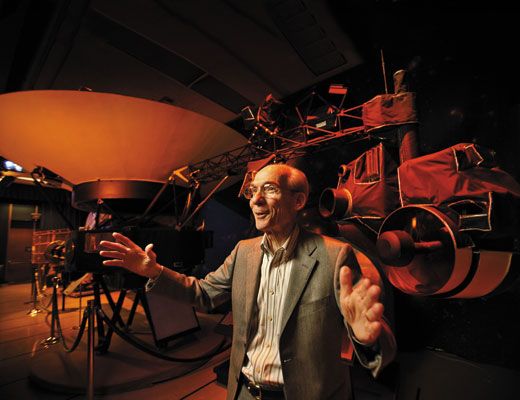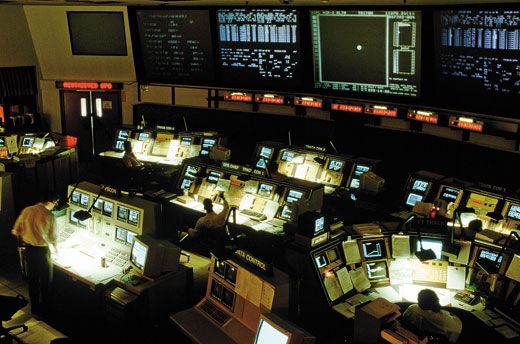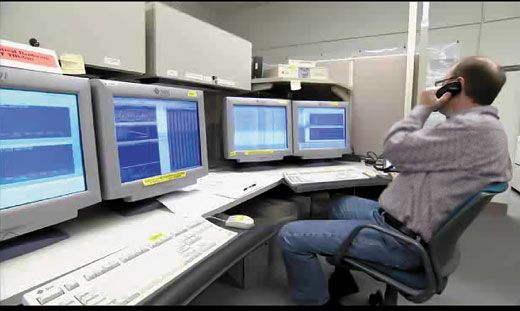More than 35 years into their mission, our farthest-flung spacecraft are not finished yet.
10 Billion Miles From Home
/https://tf-cmsv2-smithsonianmag-media.s3.amazonaws.com/filer/Voyager-Illustration-631.jpg)
Once they darted around Jupiter, Saturn, Uranus, and Neptune on a Grand Tour of the outer planets. Today, more than 35 years after they left Earth, Voyagers 1 and 2 are pressing on toward the edge of the sun’s influence. Beyond lies interstellar space, and what they’ll encounter there scientists can only guess: Nothing from Earth has been where these far-flung emissaries are going. We have a little more than a decade to find out before the Voyagers’ nuclear power source gets too weak to let the spacecraft send any more transmissions. Even with the power off, the probes will continue their solitary march. The Voyagers will then have no mission other than to exist. Long after life on Earth ends, these spacecraft will fly on, proof—if there’s anything out there to recognize it—that a civilization on a small planet in the Milky Way galaxy once reached for the stars.
One Man’s Voyager Journey
Project scientist Edward Stone is an internationally known physicist who has been on the mission since the beginning, in 1972. A familiar face to the public during the probes’ tour of the outer planets in the 1970s and 1980s, Stone went on to become director of NASA’s Jet Propulsion Laboratory in Pasadena, California, from 1991 until his retirement in 2001. Today, Stone, 77, still teaches physics at the California Institute of Technology. Voyager has been like a part of his family. When Stone began work on the mission, his two daughters, Susan and Janet, were in elementary school (and in junior high by the time of launch). Today Stone’s grandsons—a college sophomore and a high school senior—follow the Voyagers just as his daughters once did. “Voyager has been a part of our family for the last 40 years, and the major milestones in the journey were shared family milestones,” Stone says.
The Crossing
Voyager 1 crossed the termination shock—where the solar wind abruptly slows from supersonic to subsonic speeds—in December 2004 at a distance from Earth of 8.7 billion miles, while Voyager 2 crossed it in August 2007 at a distance of 7.8 billion miles. “This region of space is a better vacuum than anything on Earth, so the two spacecraft were not affected,” says Stone. “Only the instruments were sensitive to the shock.” Both spacecraft are now speeding through the outermost layer of the heliosphere, the bubble created by charged particles streaming from the sun. Once they pass through the heliosphere, they’ll encounter the ionized gas of interstellar space. “We’re expecting surprises,” says Eric Christian, a Voyager scientist at Goddard Space Flight Center in Maryland. “Up to now, everything mankind has built has been in the solar atmosphere.”
Starlight, Star Bright
If you could see the probes from Earth, Voyager 1 would appear now to be in the constellation Ophiuchus, and in 40,272 years it will pass within 1.64 light-years of the star AC+79 3888 in the constellation Camelopardalis. Voyager 2 would appear to be in the constellation Telescopium in the southern sky and will appear to enter the constellation Pavo (Peacock) in about 2015. In 40,176 years, Voyager 2 will pass within 1.65 light-years of the red dwarf star Ross 248 in the northern constellation of Andromeda.
Just Passing By
Launched on September 5, 1977, Voyager 1 overtook Pioneer 10 on February 17, 1998, becoming the most distant man-made object in space. The baton-passing occurred because of Voyager 1’s greater speed: 38,000 mph, compared with Pioneer’s 28,000 mph. Voyager 2, launched on August 20, 1977, is slightly slower than its twin at 33,500 mph. In an hour’s time, each Voyager travels the distance of about one and a half times the circumference of Earth. Voyager 1 is now 10.3 billion miles from Earth; Voyager 2 is 8.3 billion. A rare alignment of the outer planets (it occurs once every 175 years) made it possible for the Voyagers to visit all four. The spacecraft were sent on different trajectories: Both Voyagers flew by Jupiter and Saturn; Voyager 2 also visited Uranus and Neptune.
Catching Some Rays
All the planetary instruments, such as the imagers, were turned off in 1990, but the spacecraft carry other devices to study the forces of the heliosphere and interstellar space. Voyager 1 has a magnetometer and detectors to measure the mass, speed, and direction of low energy charged particles, cosmic rays, and plasma waves. Voyager 2 has the same four instruments plus an additional detector that directly measures the intensity of the solar wind.
Conditions at the Edge
The probes are finding some scientific surprises as they fly through the heliopause, where the solar wind slows from the inward pressure of the gas and magnetic field of interstellar space. Voyager 1 found that fluctuations in the solar system’s magnetic field were mostly along the direction of the motions of the planets rather than evenly distributed. It also found, contrary to what scientists had expected, that the intensity of high-energy cosmic rays tends to increase as the magnetic field and it fluctuations strengthen. Scientists had thought the fluctuations would scatter the rays. Data from the Voyagers and NASA’s Interstellar Boundary Explorer also indicate that the long-theorized bow shock (similar to the shock that causes a jet’s sonic boom) between the heliosphere and interstellar space does not exist. Rather, the heliosphere’s speed through the local interstellar cloud (a wispy hydrogen-helium mixture called the Local Fluff) is slow enough to create more of a “bow wave.”
That ’70s Show
The Voyagers carry state-of-the-art technology—for the 1970s. Aboard are an 8-track tape and analog instruments, downright primitive compared to the technology aboard modern deep space explorers. “This is back in the Atari days,” says Goddard’s Eric Christian. “Voyager’s computer has only 16K memory. Your phone has 100,000 times more than that.” Yet the probes are prodigious observers; together they have returned more than five trillion bits of data, enough to fill more than 7,000 music CDs.
Signal Events
The spacecraft transmit data daily, but are so far away it takes almost 17 hours for the signals to reach Earth. Much of the information, coming back at 160 bits per second over a period of four hours, is engineering data about the probes’ health. The feeble signals (the power level in an electronic digital watch is 20 billion times greater) are picked up by NASA’s Deep Space Network in California, Spain, and Australia, and relayed to the Jet Propulsion Laboratory, which continues to issue a weekly status report on the Voyagers. The flight team now numbers about 10, the science team about 20 part-time scientists (they also work on other space missions). That’s a far cry from the time of the planetary encounters, when “it was hundreds of people, probably 200 or more, working full time” on the science teams, says Christian, and the flight team numbered about 325. Back then, many would crowd into JPL’s control center to watch the Voyagers’ images and answer questions from reporters at the televised news conferences. Today, scientists working on Voyager can simply use their office computers to analyze the data JPL sends them.
Good as New
Despite their long journey, the spacecraft today are probably as pristine as the day they were launched. “They should look pretty good,” says Stone, who notes the probes’ plasma wave detectors record only an occasional hit from space particles. Most of the particles hit during the planetary leg of the mission when the Voyagers crossed through the ring planes of the outer planets. Solar radiation is no concern: The Voyagers were designed to withstand Jupiter’s high levels of radiation. In the environment where the probes are now, the solar radiation level is less than 1/10,000th what it is at Earth.
At Mission’s End
The Voyagers will eventually “go quiet” around 2025, when their power source—plutonium 238—has decayed to the point that transmissions end. Five years before that, scientists will have to begin turning off instruments in order to conserve signal power. “Plutonium 238 has an 88-year half-life, so we can predict when we’ll have to turn off the first instrument,” says Stone. Now that the Voyagers have reached escape velocity, they’re never coming back to the solar system. “I’ll be a little sad to see them go,” says Christian. “But it’s neat that this is mankind’s step to the stars, like a message in a bottle. This is one thing that NASA has done fantastically on, and the public has really responded. It’s real exploration.”
Paul Hoversten is the Air & Space executive editor.



